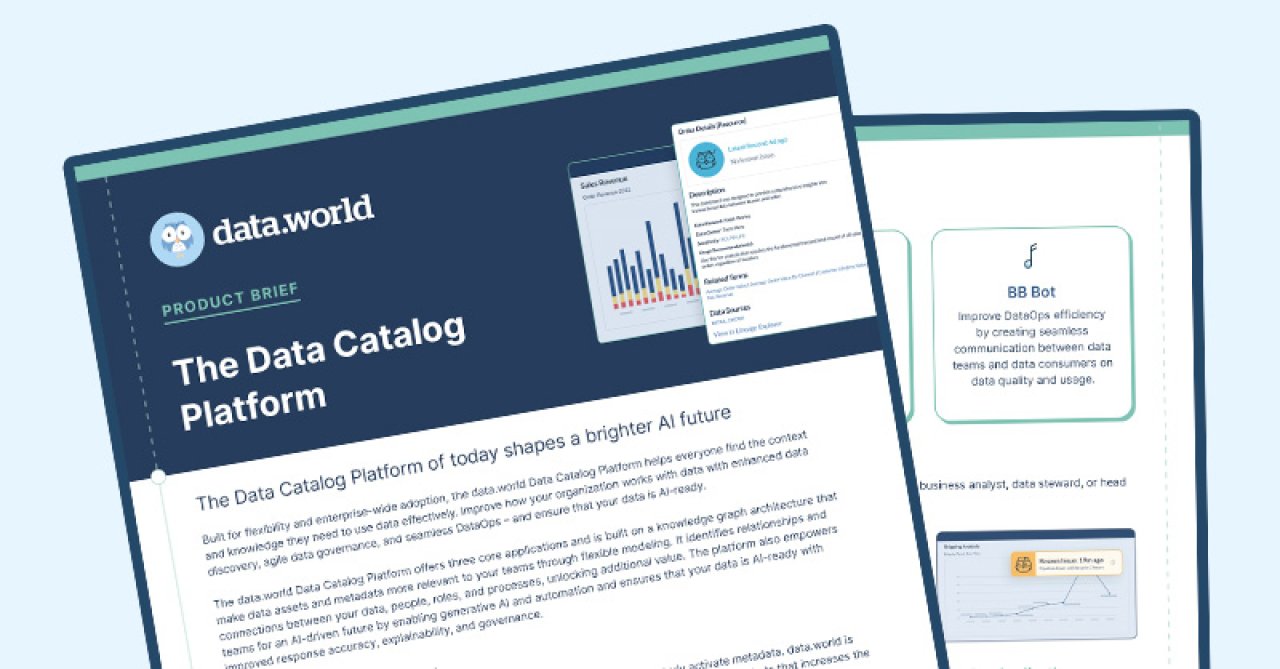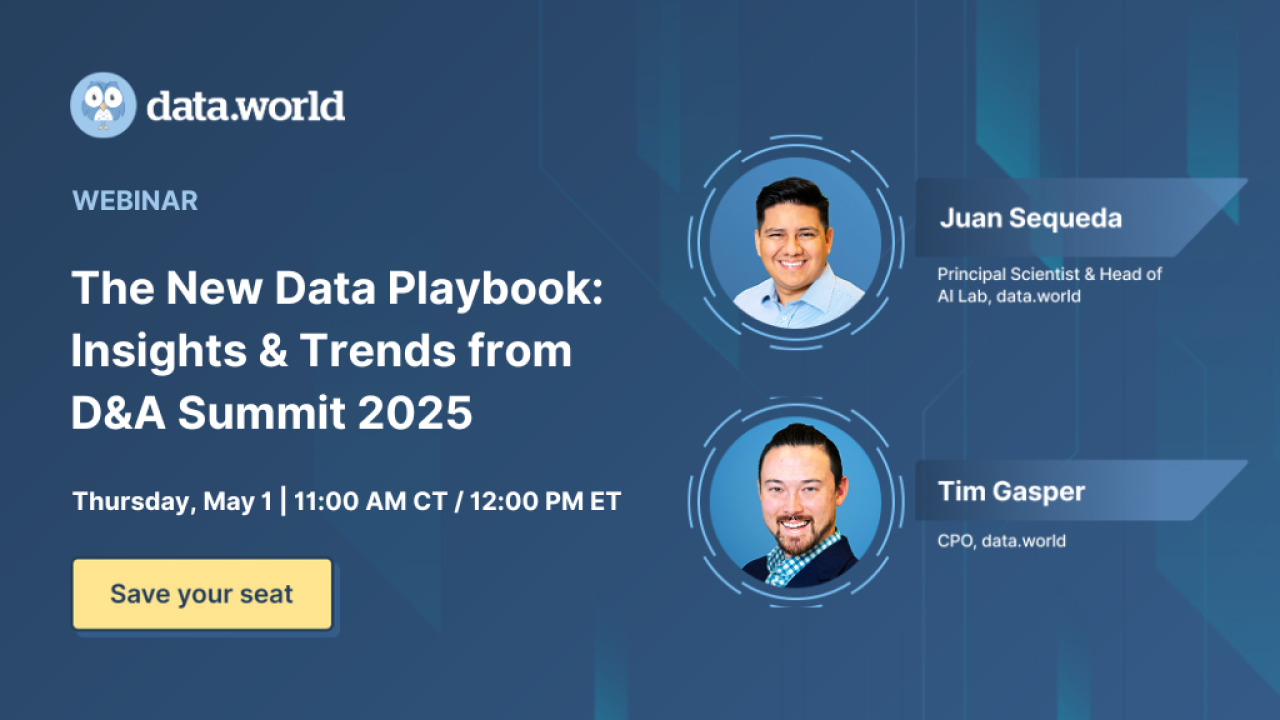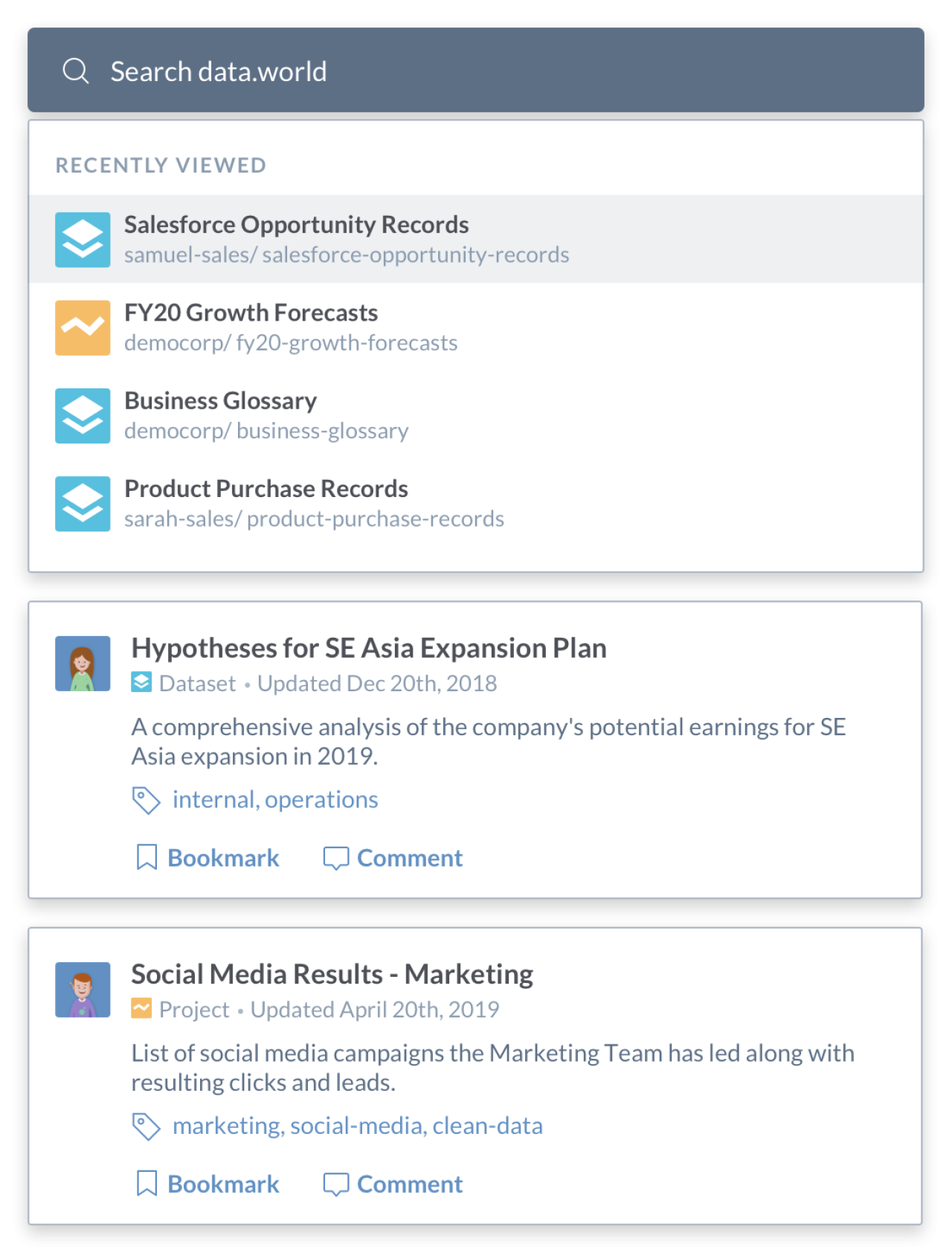























Nov 16, 2022

Your enterprise is swimming in data. But even in the era of big data, your data's only useful if your business users can get their hands on the data they need when they need it… and then understand what it's telling them.
Data discovery is an aspect of data management that involves collecting, evaluating, and connecting data from a variety of sources, cleaning and preparing that complex data, sharing it across the organization, and performing data analysis to gain valuable data driven insight into business processes. As your data volumes grow, data discovery enables a dynamic understanding of your data based on how it's ingested, stored, aggregated, and used.
The data discovery process empowers your business users and data team to get the right data at the right time when they're making important decisions for your organization.
Data discovery and data classification are closely related, e.g. usefulness, sensitivity, or security requirements. It also plays an important role in data analysis and creating easy-to-digest business intelligence (BI) insights, empowering even non-technical users to help an organization derive inform data-driven business decisions.
Also important: data discovery tools help organizations understand how they process, manage, maintain, and transfer sensitive data from multiple data sources to ensure that they're in compliance with privacy laws and regulations, including the General Data Protection Regulation (GDPR) and the California Consumer Privacy Act (CCPA).
Effective data discovery tools provide domain-specific, dynamic understanding of your company data from various sources based on how it's ingested, stored, aggregated, and used by specific consumers.
What data set is most recent? Which data sets can be deprecated?
When was the last time a table was updated?
What is the meaning of a given field in my domain?
Who has access to this data? When was the last time this data was used? By who?
What are the upstream and downstream dependencies of this data?
Is this production-quality data?
What data matters for my domain's business requirements?
What are my assumptions about this data, and are they being met?
In short, data discovery gives data scientists and business leaders an opportunity for data exploration and an under-the-hood look at their systems and operations. This, in turn, lets them better understand their business challenges, then overcome them by making more-effective, data-driven decisions via predictive analytics.
Beyond this, when analyzed, the raw data businesses collect about their customers, partners, operations, etc., becomes knowledge. Data discovery helps them to turn this knowledge into a competitive advantage.
Though they’re both approaches to finding the data you need, data search is geared toward finding specific things that are either known or assumed to exist, while data discovery uses a search/browse interface to discover what potentially useful data is available, data you may not even know exists.
Because of the massive amounts of data your enterprise collects, searching for something specific can be like looking for a needle in a haystack. This type of search experience works fine for finding something you know you already have, but it’s not great for exploring new ideas.
But when you add context to your search — when machine learning surfaces increasingly relevant results informed by your search history — you get data discovery, where your discovery experiences proactively present what you are really looking for. And because of this, discovery saves a huge amount of time, effort, and resources compared to search.
Data discovery can also be useful when metadata has been poorly managed, making data discovery even less exact. A data discovery system helps hone in on exactly what’s needed via natural language features common to popular search engines, like autocomplete, recommendation or, “did you mean”.
There are three main types of data discovery practices, and they work in concert to uncover data insights, identify security issues, and provide data analysis via easy-to-understand visual dashboards. When completed and combined with business intelligence (BI) software, these main data discovery categories result in a top-down view of a company's data in a user-friendly format.
Data preparation is the cleaning, reformatting and merging of data from different data sources across the organization so it can be analyzed in a consistent format. Steps taken to in the data preparation phase include deduplication, deleting null values, detecting outliers, and generally ensuring only high-quality data is used for business analysis. Technological advancements now allow for much of this work to be done via artificial intelligence.
A financial institution wants to analyze their business models and customer data to identify potential fraud patterns and assess risk. However, the business's data is scattered across multiple databases, with varying formats and data quality. By using data discovery tools, the institution can connect to these disparate data sources, profile the data to assess its quality, and explore the data to uncover potential fraud indicators, such as unusual transaction patterns or suspicious account activities.
By collecting data via this data discovery process, the institution can better understand the data landscape, identify data inconsistencies, and validate data accuracy. With this knowledge, they can then perform data preparation tasks, such as data cleansing, data enrichment, and data transformation, to ensure that the data is accurate, complete, and ready for analysis.
Data discovery streamlines the data preparation process by providing insights into the data and guiding the institution in transforming the data to a suitable format for analysis, enabling them to effectively detect potential fraud and manage risk in their operations.
Data visualization is one of the most effective tools data and business leaders can use to turn their data into knowledge and understand what can be gained from its analysis. Most often presented in the modern enterprise via a data dashboard, visual analytics help non-technical users understand their various data and derive business insights from them.
Data visualization would be useful in the following hypothetical example: A healthcare organization wants to analyze patient data from multiple sources to gain insights into patient outcomes and treatment effectiveness. By using data discovery tools, the organization can connect and explore the data, identifying correlations between patient demographics, treatment protocols, and outcomes.
With these insights, their data teams can create a data visualization such as a scatter plots or heat map to visually represent the relationships between different variables, helping clinicians and researchers identify patterns that can inform clinical decision-making, improve patient care, and drive better health outcomes.
Data analysis uses both descriptions and interactive visuals to paint a complete picture of a company's data in a succinct and easily understandable format. Advanced analytics empower business leaders to look beyond the data itself to see the wider implications of their data discovery efforts, uncover deep insights about their organization, and ensure accurate data in crucial business decision-making.
As an example, in a marketing use case, data discovery can help analyze customer data collected to identify trends in customer behavior, preferences, and purchase patterns. This can inform marketing strategies and campaigns, such as targeted promotions, personalized recommendations, and customer segmentation, to drive better customer engagement and improve revenue.

Data discovery tools help gain business insight by providing a complete picture of your data, enabling a big-picture view of the many data streams within your enterprise, and allowing you to uncover new insights while formulating solutions to their business challenges. It also makes data analytics understandable for stakeholders across the business, regardless of their level of data literacy.
Furthermore, data discovery helps businesses identify potential threats in their data so they can be more proactive in regard to risk management and data security. And it allows companies to apply specific real-time actions to the data they collect, ensuring it is stored and analyzed in accordance with organizational and legal guidelines, and that their data governance practices are secure and compliant.
Empowering self-service discovery and automation, allowing users to easily find and leverage data without a dedicated support team.
Leveraging machine learning to gain a bird's eye view of your data assets as they scale, ensuring that your understanding adapts as your data evolves.
Surfacing the right information at the right time and drawing connections between data assets.
Enabling dynamic discovery and a high degree of reliability across your data infrastructure, regardless of the domain or location of data storage — data warehouse, data lake, data source, etc.
Whether performing manual data discovery or using more-advanced software for big data discovery, the process usually boils down to five steps:
Understanding what data is needed
Locating the sources that will provide that data
Setting up a search query within the data
Determining the relevance of data sources, eliminating irrelevant data, and refining search queries
Evaluating the quality of the results
Unfortunately, traditional data discovery methods, such as manual search and exploration, are often time-consuming, error-prone, and inefficient. As data volumes continue to grow exponentially, businesses need smarter approaches to uncover insights from their data quickly and accurately.
This is where smart data discovery comes into play.
According to Gartner, “smart data discovery” — “a next-generation data discovery capability that provides business users or citizen data scientists with insights from advanced analytics" — is the latest advancement in this arena.
Smart, or "automated" data discovery tools use advanced algorithms and machine learning techniques to automatically identify, classify, and understand data assets within an organization's data landscape. These tools are designed to connect data from various sources, extract relevant information, and provide insights without human intervention. This type of smart data discovery makes it easier for businesses to access complex data sets, uncover data relationships, and identify patterns and trends.
In the past few years, this process has become significantly more efficient thanks to technological advances and the emergence of more-powerful artificial intelligence algorithms.
Data catalogs serve as a central repository of metadata information about an organization's data assets. Crucial for establishing effective data management practices and implementing data governance strategies, they provide a searchable inventory of multiple sources, enabling users to quickly discover and understand available data assets. Modern data catalogs have evolved to incorporate automated data discovery capabilities, making it easier for organizations to implement data discovery at scale.
Put simply, a data catalog is the search engine for your company's data.
Smart data discovery is an emerging trend in the world of data catalogs. As mentioned above, it leverages artificial intelligence (AI) and machine learning technologies to automate data discovery processes and provide intelligent recommendations to users.
Automated data discovery in data catalogs offers several significant benefits to organizations:
Time-saving and efficiency:
Automated data discovery eliminates the need for manual and time-consuming data search and exploration. It accelerates the process of finding and understanding relevant data assets, saving valuable time and resources for data practitioners.
Accurate and relevant data insights:
Automated data discovery tools use advanced algorithms to analyze data sources and provide accurate and relevant data insights. This helps organizations make informed decisions and uncover insights from their data more accurately.
Enhanced data quality:
Automated data discovery tools also assess data quality, ensuring that users access reliable and trustworthy data assets. This helps organizations maintain data integrity and make decisions based on accurate and reliable data.
Improved data governance and compliance:
Automated data discovery in data catalogs promotes data governance and data compliance by providing a centralized repository of metadata information. Most data governance strategies establish data standards, data policies, and data lineage documentation, and achieve data compliance, ensuring that data assets are utilized in a consistent and compliant manner.
Easy access to sensitive data:
Automated data discovery tools can also help organizations identify sensitive data assets, such as personally identifiable information (PII) or financial data. This helps organizations manage and protect sensitive data in accordance with data privacy regulations and policies.
Automated data discovery in data catalogs is transforming the way organizations access and analyze their data across multiple databases. By leveraging advanced algorithms and machine learning technologies, automated data discovery streamlines the data discovery process, saves time and resources, and provides accurate and relevant data insights.
As organizations continue to face ever-growing amounts of data, implementing automated data discovery in data catalogs becomes essential for businesses.
But not catalog-based data discovery tools are created equal. In fact, the most valuable methods of data discovery are ill suited for most data catalogs.
As with popular search engines — including those used by e-commerce giants like Amazon or social media sites like LinkedIn — one of the most important building blocks of an enterprise search discovery tool is a “knowledge graph,” which consists of nodes and edges representing real-world objects and the relationships between them, presenting your data ecosystem as a visualization.
This allows for more effective data discovery as users can easily navigate through the graph to explore related data, uncover hidden patterns, and gain insights from the connections between different data elements. By leveraging the relationships and context captured in a knowledge graph, users can make more informed decisions and identify relevant data points more efficiently, leading to improved data discovery and analysis capabilities.
That's why a modern data catalog equipped with a data discovery tool — and built on a knowledge-graph platform with machine learning search technology — serves as a powerful data discovery platform.
data.world's cloud-native enterprise data catalog makes it easy to find, trust, and use the data and metadata your team needs to make informed business decisions. Our enterprise data catalog simplifies the search and discovery of trusted data assets, and makes it incredibly easy to find, trust, and use the data and metadata your team needs to make informed business decisions.
Eureka Answers™ — part of our powerful suite of data governance tools — surfaces the most relevant concepts from your knowledge graph to the top of search, taming the chaos of wading through thousands of dashboards and millions of data elements by focusing only on key concepts, and enabling everyone in your organization to leverage data that drives useful context, actions, and impact.

Eureka Answers™ surfaces the most relevant concepts from the knowledge graph to the top of search. It tames the chaos of wading through thousands of dashboards and millions of data elements by focusing only on key concepts. This enables everyone in the organization to leverage data that drives useful context, actions, and impact, and empowers enterprise-wide data democratization.

Your enterprise is swimming in data. But even in the era of big data, your data's only useful if your business users can get their hands on the data they need when they need it… and then understand what it's telling them.
Data discovery is an aspect of data management that involves collecting, evaluating, and connecting data from a variety of sources, cleaning and preparing that complex data, sharing it across the organization, and performing data analysis to gain valuable data driven insight into business processes. As your data volumes grow, data discovery enables a dynamic understanding of your data based on how it's ingested, stored, aggregated, and used.
The data discovery process empowers your business users and data team to get the right data at the right time when they're making important decisions for your organization.
Data discovery and data classification are closely related, e.g. usefulness, sensitivity, or security requirements. It also plays an important role in data analysis and creating easy-to-digest business intelligence (BI) insights, empowering even non-technical users to help an organization derive inform data-driven business decisions.
Also important: data discovery tools help organizations understand how they process, manage, maintain, and transfer sensitive data from multiple data sources to ensure that they're in compliance with privacy laws and regulations, including the General Data Protection Regulation (GDPR) and the California Consumer Privacy Act (CCPA).
Effective data discovery tools provide domain-specific, dynamic understanding of your company data from various sources based on how it's ingested, stored, aggregated, and used by specific consumers.
What data set is most recent? Which data sets can be deprecated?
When was the last time a table was updated?
What is the meaning of a given field in my domain?
Who has access to this data? When was the last time this data was used? By who?
What are the upstream and downstream dependencies of this data?
Is this production-quality data?
What data matters for my domain's business requirements?
What are my assumptions about this data, and are they being met?
In short, data discovery gives data scientists and business leaders an opportunity for data exploration and an under-the-hood look at their systems and operations. This, in turn, lets them better understand their business challenges, then overcome them by making more-effective, data-driven decisions via predictive analytics.
Beyond this, when analyzed, the raw data businesses collect about their customers, partners, operations, etc., becomes knowledge. Data discovery helps them to turn this knowledge into a competitive advantage.
Though they’re both approaches to finding the data you need, data search is geared toward finding specific things that are either known or assumed to exist, while data discovery uses a search/browse interface to discover what potentially useful data is available, data you may not even know exists.
Because of the massive amounts of data your enterprise collects, searching for something specific can be like looking for a needle in a haystack. This type of search experience works fine for finding something you know you already have, but it’s not great for exploring new ideas.
But when you add context to your search — when machine learning surfaces increasingly relevant results informed by your search history — you get data discovery, where your discovery experiences proactively present what you are really looking for. And because of this, discovery saves a huge amount of time, effort, and resources compared to search.
Data discovery can also be useful when metadata has been poorly managed, making data discovery even less exact. A data discovery system helps hone in on exactly what’s needed via natural language features common to popular search engines, like autocomplete, recommendation or, “did you mean”.
There are three main types of data discovery practices, and they work in concert to uncover data insights, identify security issues, and provide data analysis via easy-to-understand visual dashboards. When completed and combined with business intelligence (BI) software, these main data discovery categories result in a top-down view of a company's data in a user-friendly format.
Data preparation is the cleaning, reformatting and merging of data from different data sources across the organization so it can be analyzed in a consistent format. Steps taken to in the data preparation phase include deduplication, deleting null values, detecting outliers, and generally ensuring only high-quality data is used for business analysis. Technological advancements now allow for much of this work to be done via artificial intelligence.
A financial institution wants to analyze their business models and customer data to identify potential fraud patterns and assess risk. However, the business's data is scattered across multiple databases, with varying formats and data quality. By using data discovery tools, the institution can connect to these disparate data sources, profile the data to assess its quality, and explore the data to uncover potential fraud indicators, such as unusual transaction patterns or suspicious account activities.
By collecting data via this data discovery process, the institution can better understand the data landscape, identify data inconsistencies, and validate data accuracy. With this knowledge, they can then perform data preparation tasks, such as data cleansing, data enrichment, and data transformation, to ensure that the data is accurate, complete, and ready for analysis.
Data discovery streamlines the data preparation process by providing insights into the data and guiding the institution in transforming the data to a suitable format for analysis, enabling them to effectively detect potential fraud and manage risk in their operations.
Data visualization is one of the most effective tools data and business leaders can use to turn their data into knowledge and understand what can be gained from its analysis. Most often presented in the modern enterprise via a data dashboard, visual analytics help non-technical users understand their various data and derive business insights from them.
Data visualization would be useful in the following hypothetical example: A healthcare organization wants to analyze patient data from multiple sources to gain insights into patient outcomes and treatment effectiveness. By using data discovery tools, the organization can connect and explore the data, identifying correlations between patient demographics, treatment protocols, and outcomes.
With these insights, their data teams can create a data visualization such as a scatter plots or heat map to visually represent the relationships between different variables, helping clinicians and researchers identify patterns that can inform clinical decision-making, improve patient care, and drive better health outcomes.
Data analysis uses both descriptions and interactive visuals to paint a complete picture of a company's data in a succinct and easily understandable format. Advanced analytics empower business leaders to look beyond the data itself to see the wider implications of their data discovery efforts, uncover deep insights about their organization, and ensure accurate data in crucial business decision-making.
As an example, in a marketing use case, data discovery can help analyze customer data collected to identify trends in customer behavior, preferences, and purchase patterns. This can inform marketing strategies and campaigns, such as targeted promotions, personalized recommendations, and customer segmentation, to drive better customer engagement and improve revenue.

Data discovery tools help gain business insight by providing a complete picture of your data, enabling a big-picture view of the many data streams within your enterprise, and allowing you to uncover new insights while formulating solutions to their business challenges. It also makes data analytics understandable for stakeholders across the business, regardless of their level of data literacy.
Furthermore, data discovery helps businesses identify potential threats in their data so they can be more proactive in regard to risk management and data security. And it allows companies to apply specific real-time actions to the data they collect, ensuring it is stored and analyzed in accordance with organizational and legal guidelines, and that their data governance practices are secure and compliant.
Empowering self-service discovery and automation, allowing users to easily find and leverage data without a dedicated support team.
Leveraging machine learning to gain a bird's eye view of your data assets as they scale, ensuring that your understanding adapts as your data evolves.
Surfacing the right information at the right time and drawing connections between data assets.
Enabling dynamic discovery and a high degree of reliability across your data infrastructure, regardless of the domain or location of data storage — data warehouse, data lake, data source, etc.
Whether performing manual data discovery or using more-advanced software for big data discovery, the process usually boils down to five steps:
Understanding what data is needed
Locating the sources that will provide that data
Setting up a search query within the data
Determining the relevance of data sources, eliminating irrelevant data, and refining search queries
Evaluating the quality of the results
Unfortunately, traditional data discovery methods, such as manual search and exploration, are often time-consuming, error-prone, and inefficient. As data volumes continue to grow exponentially, businesses need smarter approaches to uncover insights from their data quickly and accurately.
This is where smart data discovery comes into play.
According to Gartner, “smart data discovery” — “a next-generation data discovery capability that provides business users or citizen data scientists with insights from advanced analytics" — is the latest advancement in this arena.
Smart, or "automated" data discovery tools use advanced algorithms and machine learning techniques to automatically identify, classify, and understand data assets within an organization's data landscape. These tools are designed to connect data from various sources, extract relevant information, and provide insights without human intervention. This type of smart data discovery makes it easier for businesses to access complex data sets, uncover data relationships, and identify patterns and trends.
In the past few years, this process has become significantly more efficient thanks to technological advances and the emergence of more-powerful artificial intelligence algorithms.
Data catalogs serve as a central repository of metadata information about an organization's data assets. Crucial for establishing effective data management practices and implementing data governance strategies, they provide a searchable inventory of multiple sources, enabling users to quickly discover and understand available data assets. Modern data catalogs have evolved to incorporate automated data discovery capabilities, making it easier for organizations to implement data discovery at scale.
Put simply, a data catalog is the search engine for your company's data.
Smart data discovery is an emerging trend in the world of data catalogs. As mentioned above, it leverages artificial intelligence (AI) and machine learning technologies to automate data discovery processes and provide intelligent recommendations to users.
Automated data discovery in data catalogs offers several significant benefits to organizations:
Time-saving and efficiency:
Automated data discovery eliminates the need for manual and time-consuming data search and exploration. It accelerates the process of finding and understanding relevant data assets, saving valuable time and resources for data practitioners.
Accurate and relevant data insights:
Automated data discovery tools use advanced algorithms to analyze data sources and provide accurate and relevant data insights. This helps organizations make informed decisions and uncover insights from their data more accurately.
Enhanced data quality:
Automated data discovery tools also assess data quality, ensuring that users access reliable and trustworthy data assets. This helps organizations maintain data integrity and make decisions based on accurate and reliable data.
Improved data governance and compliance:
Automated data discovery in data catalogs promotes data governance and data compliance by providing a centralized repository of metadata information. Most data governance strategies establish data standards, data policies, and data lineage documentation, and achieve data compliance, ensuring that data assets are utilized in a consistent and compliant manner.
Easy access to sensitive data:
Automated data discovery tools can also help organizations identify sensitive data assets, such as personally identifiable information (PII) or financial data. This helps organizations manage and protect sensitive data in accordance with data privacy regulations and policies.
Automated data discovery in data catalogs is transforming the way organizations access and analyze their data across multiple databases. By leveraging advanced algorithms and machine learning technologies, automated data discovery streamlines the data discovery process, saves time and resources, and provides accurate and relevant data insights.
As organizations continue to face ever-growing amounts of data, implementing automated data discovery in data catalogs becomes essential for businesses.
But not catalog-based data discovery tools are created equal. In fact, the most valuable methods of data discovery are ill suited for most data catalogs.
As with popular search engines — including those used by e-commerce giants like Amazon or social media sites like LinkedIn — one of the most important building blocks of an enterprise search discovery tool is a “knowledge graph,” which consists of nodes and edges representing real-world objects and the relationships between them, presenting your data ecosystem as a visualization.
This allows for more effective data discovery as users can easily navigate through the graph to explore related data, uncover hidden patterns, and gain insights from the connections between different data elements. By leveraging the relationships and context captured in a knowledge graph, users can make more informed decisions and identify relevant data points more efficiently, leading to improved data discovery and analysis capabilities.
That's why a modern data catalog equipped with a data discovery tool — and built on a knowledge-graph platform with machine learning search technology — serves as a powerful data discovery platform.
data.world's cloud-native enterprise data catalog makes it easy to find, trust, and use the data and metadata your team needs to make informed business decisions. Our enterprise data catalog simplifies the search and discovery of trusted data assets, and makes it incredibly easy to find, trust, and use the data and metadata your team needs to make informed business decisions.
Eureka Answers™ — part of our powerful suite of data governance tools — surfaces the most relevant concepts from your knowledge graph to the top of search, taming the chaos of wading through thousands of dashboards and millions of data elements by focusing only on key concepts, and enabling everyone in your organization to leverage data that drives useful context, actions, and impact.

Eureka Answers™ surfaces the most relevant concepts from the knowledge graph to the top of search. It tames the chaos of wading through thousands of dashboards and millions of data elements by focusing only on key concepts. This enables everyone in the organization to leverage data that drives useful context, actions, and impact, and empowers enterprise-wide data democratization.
Get the best practices, insights, upcoming events & learn about data.world products.